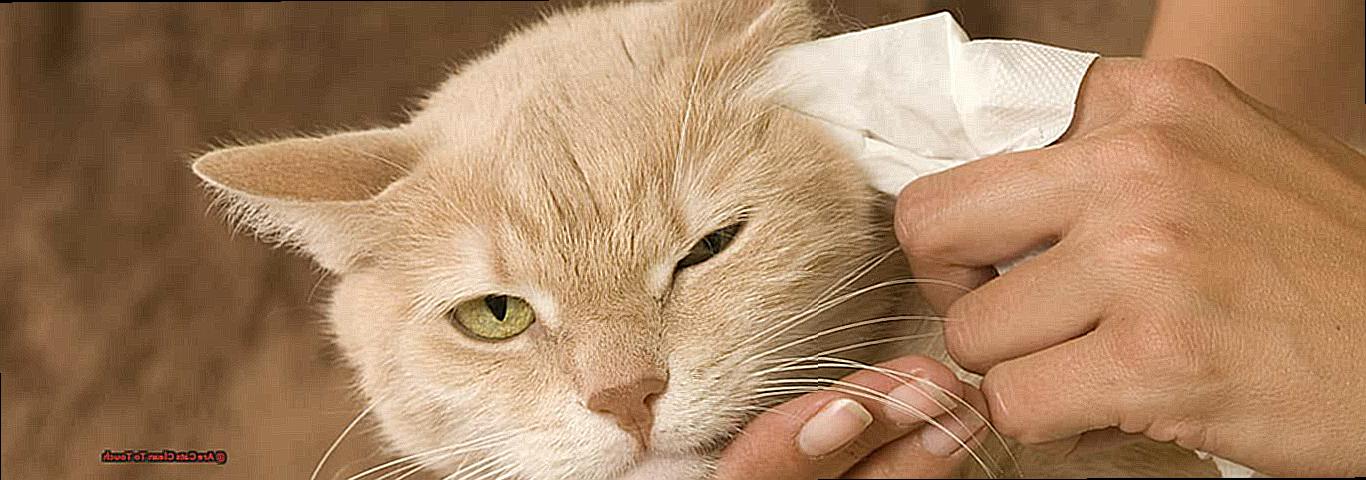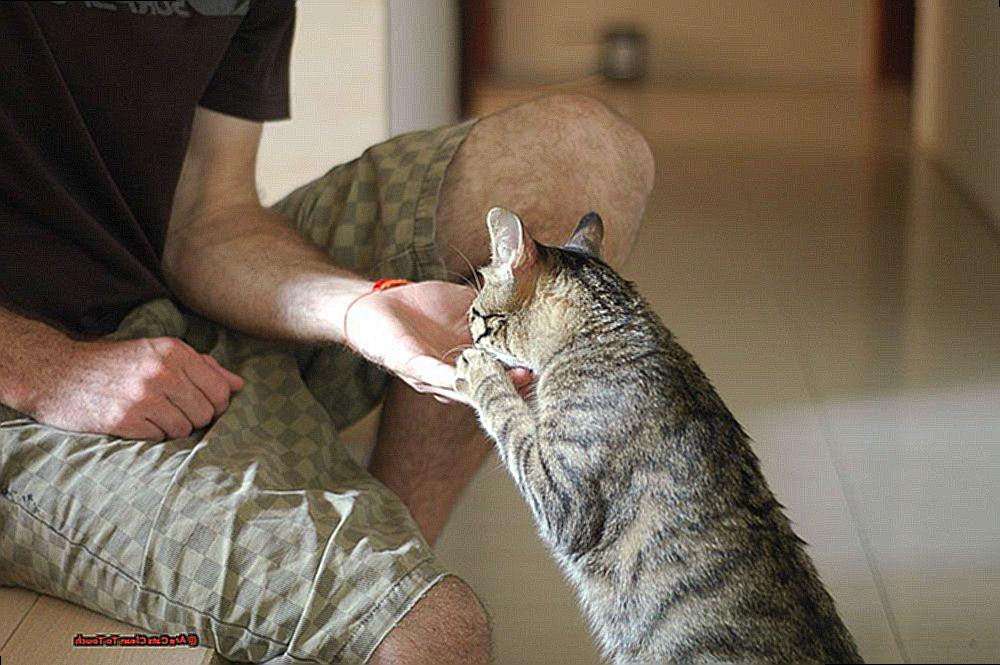The sleek, graceful creatures that seem to have cleanliness on lock. With their constant grooming and impeccable litter box manners, it’s no wonder they’re often hailed as the epitome of cleanliness in the pet world.
But are cats really as spotless as we make them out to be? Let’s dig into the truth behind their reputation and uncover some fascinating facts about our feline friends’ hygiene habits.
So, sit back, relax, and join me for a cup of coffee as we explore just how clean cats truly are.
Are Cats Clean To Touch?
Contents
Cats are renowned for their cleanliness and grooming habits, spending hours each day meticulously licking themselves to keep their fur clean and shiny. But the question remains – are cats actually clean to touch? As a cat expert, I’m here to delve into this debate and provide some insight on the topic.
The Unique Saliva of Cats:
One factor to consider when determining if cats are clean to touch is their saliva. Cats have a unique type of saliva that contains enzymes that can help clean their fur and skin. It’s almost like a built-in grooming tool. However, this saliva can also transfer allergens and bacteria onto surfaces, including human skin. So, while it may help to keep their fur clean, it can also pose a risk for those with allergies or weakened immune systems.
Grooming Habits and Environment:
Another aspect to consider is where cats groom themselves. Cats often groom themselves in hard-to-reach areas, such as their back and hind legs. This means that there may be areas on a cat’s body that are not as clean as others. Additionally, cats may also groom themselves after using the litter box, which can transfer bacteria onto their paws and potentially onto surfaces they come into contact with.
The cleanliness of a cat’s environment also plays a role in how clean they are to touch. Indoor cats tend to be cleaner than outdoor cats as they are not exposed to as many environmental contaminants and dirt. This makes them safer to touch. Plus, with regular cleaning and maintenance of their living space, the risk of bacteria and germs on their fur is significantly reduced.
Potential Risks:
It’s also essential to note that while cats may seem clean on the surface, they can carry certain bacteria and parasites that can be harmful to humans. These include bacteria like Salmonella and parasites like Toxoplasma gondii, which can be transmitted through contact with a cat’s feces or contaminated surfaces. While this may sound alarming, with proper hygiene practices and precautions, the risk of contracting these illnesses is minimal.
Understanding the Grooming Habits of Cats

If you’re a cat owner, you have probably noticed that your furry friend spends a considerable amount of time grooming themselves. In fact, cats can spend up to 50% of their waking hours grooming.
But have you ever wondered why they do this? And what does it mean for their overall health and happiness? Let’s dive into the secrets behind your cat’s grooming habits.
The Power of the Tongue
Cats are known for their rough tongues, which are covered in tiny barbs called papillae. These barbs serve as a comb, helping them to remove loose hair and debris from their fur. This natural grooming tool is just one of the many reasons why cats are such fastidious groomers.
More Than Just Cleanliness
Grooming is not just about staying clean for cats. It also serves several other important purposes. One of these is regulating body temperature. By licking their fur, cats spread saliva that evaporates and cools their skin. This is especially important for long-haired breeds in hot weather.
Grooming also helps to distribute natural oils throughout a cat’s fur, keeping it shiny and healthy. It also stimulates blood flow and aids in shedding old fur to make way for new growth.
The Importance of Brushing
Although your cat may be a great self-groomer, they still need some help from us humans. Regular brushing is essential for preventing matting and hairballs, especially for long-haired cats. It also provides an opportunity for us to bond with our feline companions.
Some cats may have difficulty grooming themselves due to age, obesity, or certain health conditions. In these cases, regular brushing becomes even more crucial.
Detecting Skin Issues
Regular grooming also allows you to keep an eye on your cat’s skin health. By running your hands over their body, you can feel for any abnormal lumps, bumps, or scabs. You can also check for fleas, ticks, or other parasites that may be hiding in their fur.
Grooming as a Form of Communication
Cats are not just grooming themselves for cleanliness and health reasons. They also use grooming as a way to communicate with other cats. Mothers groom their kittens as a form of affection and bonding. Similarly, cats may also groom each other to show affection and strengthen social bonds.
The Protein Fel d 1 and Its Effects on Humans
If you’re a cat owner, you may be familiar with the term “Fel d 1.” But do you know what it is and how it can impact your health? As experts on this topic, we’re here to educate you on the protein Fel d 1 and its effects on humans.
What is Fel d 1?
Fel d 1 is a protein produced by cats in their saliva, skin, and urine. It’s a small protein, about the size of a dust particle, and can easily become airborne. This means that even if you don’t have direct contact with a cat, you can still be exposed to Fel d 1.
Why Does Fel d 1 Cause Allergic Reactions?
Fel d 1 is known to trigger allergies in some humans. This protein can stick to clothing, furniture, and other surfaces, making it difficult to avoid. When exposed to Fel d 1, sensitive individuals may experience allergic reactions such as sneezing, itchy eyes, and even asthma attacks.
Factors That Affect Fel d 1 Production
Not all cats produce the same levels of Fel d Some breeds are known to have lower levels of this protein. Additionally, the amount of Fel d 1 produced by a cat can vary based on factors such as age, gender, and whether or not the cat is neutered.
Male cats tend to produce higher levels of Fel d 1 compared to females. However, neutering male cats can reduce their production of this protein by up to 90%. So for those who are allergic to cats but still want one as a pet, consider adopting a neutered male cat.
Other factors that can affect the production of Fel d 1 in cats include their diet and grooming habits. Regular brushing and bathing can help reduce the amount of Fel d 1 on a cat’s fur. Some studies also suggest that making diet changes for your cat can help lower their production of Fel d 1.
Take Action to Reduce Your Exposure to Fel d 1
If you’re allergic to cats, there are ways to reduce your exposure to Fel d Regularly brushing and bathing your cat, keeping them on a healthy diet, and considering adopting a neutered male cat are all effective ways to lower the levels of Fel d 1 in your home.
Bacteria and Germs on a Cat’s Fur and Paws
Cats are known for their fastidious grooming habits, spending hours licking their fur and paws until they are clean and shiny. But as much as we love our feline friends, it’s important to recognize that even with their regular self-cleaning routines, cats can still carry harmful bacteria and germs on their fur and paws.
According to a study by the National Center for Biotechnology Information (NCBI), cats can harbor a variety of bacteria on their skin and fur. These bacteria can come from various sources such as the environment, prey animals, or other cats that the cat may have come into contact with. This means that even if your cat is an indoor-only pet, they can still be exposed to bacteria and bring them into your home.
One of the most common bacteria found on a cat’s fur and paws is Pasteurella multocida. This bacterium is known to cause skin infections and respiratory problems in humans. Another concerning bacteria that cats can carry is Salmonella, which can cause food poisoning and other gastrointestinal issues. Staphylococcus aureus and Streptococcus canis are also commonly found on cats and can lead to skin infections and other health problems.
But it’s not just bacteria that cat owners need to be aware of. Cats can also carry viruses on their fur and paws, such as feline herpesvirus and feline calicivirus. These viruses can be transmitted to humans through direct contact with the cat’s fur or paws, or through contact with contaminated surfaces that the cat has touched.
It’s important to note that while cats may carry these bacteria and viruses, they may not necessarily show any symptoms of illness themselves. This makes it even more crucial for owners to practice good hygiene when handling their cats. Be sure to wash your hands after petting or playing with your cat, and avoid letting them lick your face or any open wounds.
Additionally, keeping your cat’s living space clean can also help reduce the spread of bacteria and viruses. Regularly cleaning and disinfecting their litter box, food and water bowls, and any other surfaces they may come into contact with can help reduce the risk of contamination.
Factors Affecting a Cat’s Cleanliness: Diet, Environment, and Genetics
We all know that cats are self-grooming masters, but did you know that there are other factors besides grooming that can affect their cleanliness? As an expert in the topic, I’ll be sharing with you the key factors that can impact your furry friend’s skin, coat, and hygiene.
- Diet: You are what you eat, and this applies to cats too. A high-quality diet with all the necessary nutrients is essential for maintaining your cat’s skin and coat health. A poor diet lacking essential nutrients can lead to dull fur, excessive shedding, and skin problems, making your cat appear unclean. So make sure to feed your cat a balanced diet to keep their coat shiny and clean.
- Environment: The cleanliness of your cat also depends on their living environment. Cats that are kept in clean and hygienic spaces tend to be cleaner themselves. This is because they are less likely to come into contact with dirt, bacteria, and other contaminants that can affect their cleanliness. Ensure your cat’s living space is regularly cleaned and sanitized to keep them feeling and looking their best.
- Genetics: Just like humans, some cats may naturally have a higher tendency towards cleanliness due to their genetic makeup. Certain breeds, such as the Siamese and Sphynx, are known for their fastidious grooming habits and therefore tend to be cleaner than others. On the other hand, some breeds may have longer or thicker fur, making it more challenging for them to keep themselves clean. In such cases, regular grooming by their owners may be necessary to maintain their cleanliness.
But wait, there’s more. Did you know that a combination of these factors can greatly impact a cat’s cleanliness? A well-balanced diet, a clean living environment, and genetic predispositions all play a significant role in how clean a cat appears and feels to touch. As a responsible cat owner, it is essential to pay attention to these factors and take necessary steps to ensure your feline companion stays clean and healthy.
Proper Grooming Practices for Cats to Keep Them Clean
As much as we may love our furry feline friends, there’s no denying that cats can sometimes be a little…well, lazy. And let’s face it, grooming is just not high on their list of priorities. But as responsible pet owners, it’s up to us to make sure our cats stay clean and healthy. So, let’s dive into the essential steps for proper cat grooming.
First and foremost, regular brushing is crucial for maintaining your cat’s coat and overall hygiene. Not only does it remove any loose hair and dirt, but it also helps distribute natural oils throughout their fur, keeping it soft and shiny. Plus, it’s a great bonding activity for you and your cat.
But what about bathing? Contrary to popular belief, most cats do not need regular baths unless they have a medical condition or have gotten into something particularly dirty. However, if you do need to bathe your cat, make sure to use gentle products and lukewarm water to avoid any unnecessary stress for your feline friend.
Next up, nail trimming. This may seem like a daunting task, but it’s an essential part of grooming and helps prevent your cat’s claws from becoming too sharp. Plus, it can prevent them from getting tangled in things or causing harm to themselves while scratching. If you’re unsure how to trim your cat’s nails, ask your veterinarian for a demonstration.
Cleaning your cat’s ears is another important aspect of grooming. Using a damp cotton ball or specialized ear cleaner approved by your veterinarian can help remove any dirt or wax buildup in their ears. This is especially important for cats with long or floppy ears, as they are more prone to ear infections.
We can’t forget about dental care. Just like us humans, cats need proper dental care too. Regular brushing or providing dental treats can help prevent dental issues such as tartar buildup and gum disease. And trust me, no one wants to deal with a cat’s bad breath.
In addition to these grooming practices, it’s also essential to regularly clean your cat’s bedding and litter box. Using a mild detergent and changing the litter regularly can help prevent any bacteria or parasites from thriving in their environment.
And last but certainly not least, regular visits to the vet are crucial for maintaining your cat’s overall health and hygiene. Your veterinarian can perform thorough examinations and identify any potential issues that need to be addressed.
Precautions for Handling Cats: Hand Washing and Allergies
We can relate. But as much as we adore our cats, it’s important to take precautions when handling them to keep ourselves and our pets healthy. In this blog post, we’ll be discussing the essential precautions for handling cats, including hand washing and managing allergies.
First things first, let’s talk about hand washing. You may think that your cat is clean enough to touch without washing your hands, but the truth is, even the cleanest of cats can carry bacteria or parasites on their fur or paws. That’s why it’s crucial to wash your hands before and after handling your cat. Use warm water and soap, and make sure to scrub between your fingers and under your nails for at least 20 seconds. This is especially important after handling a litter box or playing with a cat that has been outdoors.
Aside from hand washing, regular grooming for your cat is also vital in keeping them clean and reducing the risk of transferring dirt or allergens. Regular brushing and bathing can help remove any debris from their coat and make them less likely to spread it around. Plus, who doesn’t love a well-groomed and silky-smooth kitty?
But what about those who suffer from allergies? We know how tough it can be to resist petting an adorable kitty even when you’re allergic. That’s why we recommend taking extra precautions when handling cats if you have allergies. Some tips include wearing gloves or a mask, washing your hands immediately after handling the cat, and avoiding rubbing your eyes or face while near them. It may also be helpful to keep cats out of your bedroom or other areas where you spend a lot of time to reduce exposure to allergens in the air.
If you have severe allergies, it’s best to consult with an allergist before bringing a cat into your home. They can provide further advice on how to manage your allergies while caring for a cat. But don’t let allergies stop you from experiencing the joy of owning a cat. With proper precautions, you can still enjoy all the cuddles and playtime with your feline friend.
Conclusion
In conclusion, while cats may seem like the epitome of cleanliness in the pet world, there are various factors that can affect how clean they truly are to touch. Their constant grooming and unique saliva do contribute to their overall cleanliness, but other elements such as diet, environment, and genetics also play a significant role.
A well-balanced diet is essential for maintaining a cat’s cleanliness. A nutrient-rich diet can lead to a healthier coat and skin, making them less prone to dirt and odors. Similarly, a clean living space can prevent your feline friend from picking up any unwanted bacteria or parasites. And let’s not forget about genetic predispositions – some cats may naturally have oilier coats or be more prone to skin conditions, making them feel less clean to touch.
Proper grooming practices are crucial for keeping cats clean and healthy. Regular brushing not only removes loose fur and debris but also spreads natural oils throughout their coat for a shiny appearance. Trimming nails prevents scratches and potential infections, while cleaning ears and teeth can prevent unpleasant odors.
As responsible cat owners, it’s important to take precautions when handling our furry companions. This includes washing our hands before and after touching them, managing allergies if necessary, and keeping their living space clean. Regular visits to the vet for check-ups can also help maintain their overall health and hygiene.
So, while cats may not be as pristine as they appear on the surface, with proper care and attention from us humans, they can still be clean and healthy animals that we love to snuggle up with.






